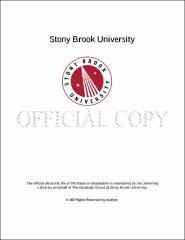| dc.identifier.uri | http://hdl.handle.net/11401/76763 | |
| dc.description.sponsorship | This work is sponsored by the Stony Brook University Graduate School in compliance with the requirements for completion of degree. | en_US |
| dc.format | Monograph | |
| dc.format.medium | Electronic Resource | en_US |
| dc.language.iso | en_US | |
| dc.publisher | The Graduate School, Stony Brook University: Stony Brook, NY. | |
| dc.type | Dissertation | |
| dcterms.abstract | This dissertation is focused on the estimation of time series models with the main area of interest being the use of fractional methods in political science. Since the work of Granger (1980), Granger and Joyeux (1980) and Hosking (1981) initially introduced the concept of fractional integration the area of study has continued to grow in economics. In political science however, research into fractional integration has failed to advance beyond an initial flurry of study that began in the late 1990s and early 2000s. This dissertation contains three stand alone chapters that are focused on the use of fractional methods with political time series. Each attempts to address concerns that have previously dissuaded broader usage of fractional techniques. Chapter 2 attempts to move beyond the aggregation work of Granger (1980) by offering a second justification for the presence of fractionally integrated political series - the error du- ration process of Parke (1999). Using the error duration model to investigate the survival of federal policies, survival probabilities of American federal programs are found to be fraction- ally integrated. Chapter 3 provides the results of a Monte Carlo study of various parametric and semiparametric estimators of long-memory with smaller sample sizes commonly found in political science. This is the first comprehensive simulation of multiple estimators with samples of less than 100. The results indicate that fractional integration can be reliably estimated with data of smaller samples, however the proper frequency domain estimators must be used depending on the data type. Chapter 4 is co-authored with Matthew Lebo. All model estimates, Monte Carlo simulations, figures, and all material found in the appendix for this chapter were solely my own work product. The chapter discusses the single-equation error correction model that is now common in political time series, and diagnoses several problems with the way the method has been employed up to this point. Alternative models are offered in place of the general error correction model. | |
| dcterms.available | 2017-09-20T16:51:08Z | |
| dcterms.contributor | Lebo, Matthew | en_US |
| dcterms.contributor | Peress, Michael | en_US |
| dcterms.contributor | Kellstedt, Paul. | en_US |
| dcterms.contributor | Segal, Jeffrey | en_US |
| dcterms.creator | Grant, Taylor | |
| dcterms.dateAccepted | 2017-09-20T16:51:08Z | |
| dcterms.dateSubmitted | 2017-09-20T16:51:08Z | |
| dcterms.description | Department of Political Science. | en_US |
| dcterms.extent | 233 pg. | en_US |
| dcterms.format | Application/PDF | en_US |
| dcterms.format | Monograph | |
| dcterms.identifier | http://hdl.handle.net/11401/76763 | |
| dcterms.issued | 2015-12-01 | |
| dcterms.language | en_US | |
| dcterms.provenance | Made available in DSpace on 2017-09-20T16:51:08Z (GMT). No. of bitstreams: 1
Grant_grad.sunysb_0771E_12401.pdf: 2936634 bytes, checksum: 313cfbef8389d201b88d716937edf546 (MD5)
Previous issue date: 1 | en |
| dcterms.publisher | The Graduate School, Stony Brook University: Stony Brook, NY. | |
| dcterms.subject | Political science | |
| dcterms.title | Fractional Time Series Applications in Political Science | |
| dcterms.type | Dissertation | |

